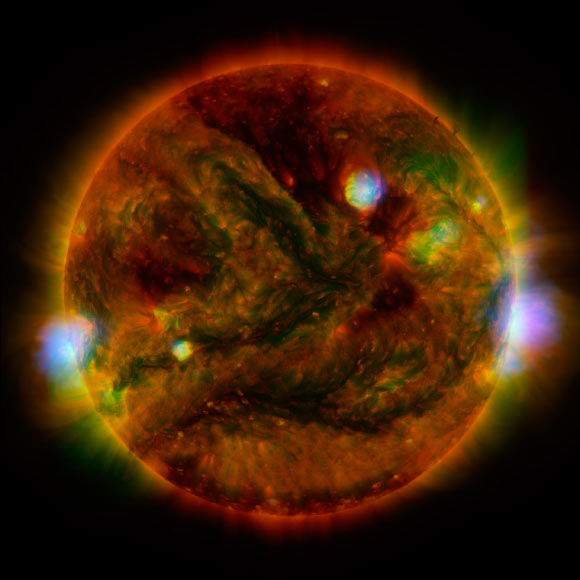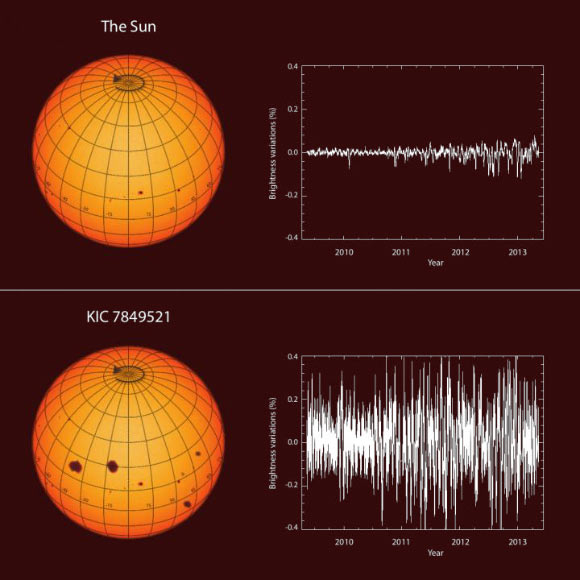Study: Our Sun is Less Active than Other Solar-Type Stars | Astronomy – Sci-News.com
Magnetic activity on the Sun leads to solar flares, coronal mass ejections, and other space weather that affects Earth. Similar activity on other stars may determine the habitability of any orbiting exoplanets. In a study published in the journal Science, an international team of scientists analyzed brightness variations of 369 solar-type stars to infer their activity levels and found that the Sun is less active than most of the solar-type stars in the sample.

Flaring, active regions of the Sun are highlighted in this image combining observations from several telescopes. High-energy X-rays from NASA’s Nuclear Spectroscopic Telescope Array (NuSTAR) are shown in blue; low-energy X-rays from Japan’s Hinode spacecraft are green; and extreme ultraviolet light from NASA’s Solar Dynamics Observatory (SDO) is yellow and red. All three telescopes captured their solar images around the same time on April 29, 2015. Image credit: NASA / JPL-Caltech / GSFC / JAXA.
Like other main-sequence stars, the Sun possesses a powerful magnetic field that generates dark sunspots, bright solar flares, and other visible features.
These magnetic imprints vary over time and temporarily affect the variability of the star’s light output, causing the Sun to go through an 11-year cycle of higher and lower activity.
Understanding the magnetic field of the Sun is critical for predicting the star’s future, but scientists debate whether the Sun’s activity will diminish or may still become more magnetically active.
“The speed at which a star rotates around its own axis is a crucial variable. A star’s rotation contributes to the creation of its magnetic field in a dynamo process in its interior,” said co-author Dr. Sami Solanki, a researcher in the Max-Planck-Institut für Sonnensystemforschung and the School of Space Research at Kyung Hee University.
“The magnetic field is the driving force responsible for all fluctuations in activity.”
“The state of the magnetic field determines how often the Sun emits energetic radiation and hurls particles at high speeds into space in violent eruptions, how numerous dark sunspots and bright regions on its surface are — and thus also how brightly the Sun shines.”

Brightness variations of the Sun and a solar-type star called KIC 7849521. Image credit: Max-Planck-Institut für Sonnensystemforschung / hormesdesign.de.
Dr. Solanki and colleagues compared the Sun’s brightness variations to observations of 369 solar-type stars with similar masses, temperatures, compositions and rotational properties.
The researchers combined 4 years of photometric observations from NASA’s Kepler Space Telescope with astrometric data from ESA’s star-mapping satellite Gaia.
They found that most were more active than the Sun, often being five times more variable than the Sun was over the last 140 years.
“We were very surprised that most of the Sun-like stars are so much more active than the Sun,” said co-author Dr. Alexander Shapiro, from the Max-Planck-Institut für Sonnensystemforschung.
The authors offer several potential explanations for their observations, including possibilities that the Sun can have higher variability over long timescales, or differs from similar stars in ways that haven’t yet been recognized.
“After all, our star is almost 4.6 billion years old,” said lead author Dr. Timo Reinhold, a scientist in the Max-Planck-Institut für Sonnensystemforschung.
“It is conceivable that the Sun has been going through a quiet phase for thousands of years and that we therefore have a distorted picture of our star.”
_____
Timo Reinhold et al. 2020. The Sun is less active than other solar-like stars. Science 368 (6490): 518-521; doi: 10.1126/science.aay3821





